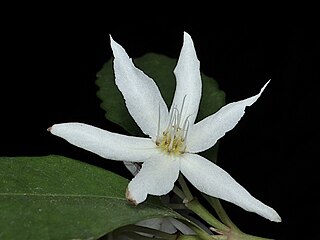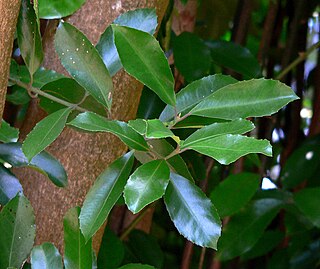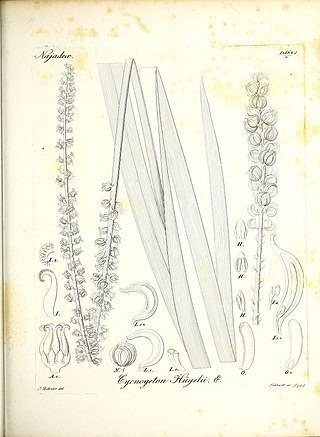
The Canellaceae are a family of flowering plants in the order Canellales. The order includes only one other family, the Winteraceae. Canellaceae is native to the Afrotropical and Neotropical realms. They are small to medium trees, rarely shrubs, evergreen and aromatic. The flowers and fruit are often red.

Stephan Friedrich Ladislaus Endlicher, also known as Endlicher István László, was an Austrian botanist, numismatist and Sinologist. He was a director of the Botanical Garden of Vienna.

Hibbertia stellaris, commonly known as star guinea flower or orange stars, is a brilliantly orange flowering ground cover from the South Western Australian botanical province. It naturally grows in swamps; despite this, it is extremely sensitive to phytophthora and needs to be grown in well-drained soil in cultivation.

Acanthocephalus is a genus of plants in the family Asteraceae, described as a genus in 1842.

Banksia sect. Eubanksia is an obsolete section of Banksia. There have been two circumscriptions, one of which is synonymous with the recently abandoned B. subg. Banksiasensu Alex George, the other having no modern equivalent.

Hypocalymma is a genus of evergreen shrubs in the myrtle family Myrtaceae described as a genus in 1840. The entire genus is endemic to southern Western Australia.

Eremophila deserti is a shrub which is endemic to Australia. Common names for this species include turkey bush, dogwood, poison bushEllangowan poison bush, pencil bush and carrot bush. It is common and widespread in all mainland states, although not the Northern Territory. Some forms are poisonous to stock.

Atherosperma moschatum, commonly known as black sassafras, Australian sassafras, southern sassafras, native sassafras or Tasmanian sassafras, is a flowering plant in the family Atherospermataceae and the only species in the genus Atherosperma. It is a shrub to conical tree and is endemic to south-eastern Australia. It has densely hairy young branchlets, flowers and the lower surface of the leaves. Its leaves are lance-shaped to elliptic, sometimes with toothed edges, the flowers perfumed and white to cream, and the fruit is an achene.

Doryphora sassafras, commonly known as sassafras, yellow sassafras, golden deal or golden sassafras, is a species of flowering plant in the Southern Sassafras Family Atherospermataceae and is endemic to eastern Australia. It is a shrub to tree with elliptic or egg-shaped leaves and contrasting white flowers which occur in autumn and winter.

Hedycarya is a genus of about 16 species of flowering plants in the family Monimiaceae native to eastern Australia, New Zealand, and some Pacific Islands. Plants in the genus Hedycarya are shrubs, or small to medium trees with sometimes toothed leaves. The male and female flowers cup-shaped and are borne on separate plants. Male flowers usually have 8 tepals and many stamens and female flowers are have 6 to 12 tepals with many carpels. The fruit is a cluster of drupes.

Wilkiea is a genus of flowering plants in the family Monimiaceae, and is native to Australia and New Guinea. Plants in this genus are monoecious or sometimes dioecious trees and shrubs, the leaves with many fine oil dots, male and female flowers in cymes or panicles, and oval black drupes.

Pericalymma is a group of plants in the myrtle family Myrtaceae described as a genus in 1840. The entire genus is endemic to Western Australia.
- Pericalymma crassipes(Lehm.) Schauer
- Pericalymma ellipticum(Endl.) Schauer
- Pericalymma megaphyllumCranfield
- Pericalymma spongiocauleCranfield

Melaleuca teretifolia is a plant in the myrtle family, Myrtaceae, which is endemic to the south-west of Western Australia. It is a shrub with long, thin leaves and clusters of usually white flowers along considerable lengths of the branches in late spring and summer.

Boronia falcifolia, commonly known as the wallum boronia, is a plant in the citrus family, Rutaceae and is endemic to near-coastal areas of eastern Australia. It is a shrub with only a few stems, usually three-part leaves and bright pink, four-petalled flowers.

Josef Zehner aka Joseph Zehner was an Austrian botanical illustrator. The plant genus Zehneria in the family Cucurbitaceae was named in his honour.

Hibbertia huegelii is a species of flowering plant in the family Dilleniaceae and is endemic to the south-west of Western Australia. It is an erect, spreading or prostrate shrub with hairy branchlets, linear leaves and yellow flowers arranged singly in leaf axils on the ends of shoots, with fifteen to twenty-five stamens in bundles around the four or five carpels.

Palmeria hypotephra is a species of flowering plant in the family Monimiaceae and is endemic to Queensland. It is a woody climber with elliptic to egg-shaped leaves, male and female flowers on separate plants with 4 or 5 tepals, male flowers with 30 to 35 stamens, female flowers with 10 to 12 carpels, and spherical, dark brown to black drupes.

Palmeria foremanii, commonly known as anchor vine, is a species of flowering plant in the family Monimiaceae and is endemic to an area near the New South Wales - Queensland border. It is a tall, woody climber or scrambling shrub with usually elliptic leaves, male and female flowers on separate plants with 5 tepals, male flowers with 40 to 43 stamens, female flowers with 7 to 12 carpels, and spherical, shiny black drupes.

Doryphora aromatica, commonly known as sassafras, northern sassafras, northern grey sassafras, net sassafras or grey sassafras, is a species of flowering plant in the Southern Sassafras Family Atherospermataceae and is endemic to north-east Queensland. It is a tree with elliptic or egg-shaped leaves with the narrower end towards the base, white flowers with 5 stamens and 6 to 8 carpels, and achenes splitting to release feather-like fruits.

Wilkiea macrophylla, commonly known as large-leaved wilkiea, is a species of flowering plant in the family Monimiaceae, and is endemic to north-eastern Australia. It is a glabrous shrub or small tree with narrowly to broadly elliptic leaves, and male and female flowers on separate plants. Male flowers have 2 pairs of tepals and usually 2 pairs of stamens, and female flowers have 6 or 7 pairs of tepals and 13 to 20 carpels. The fruit is a glossy purplish to olive black drupe.



















